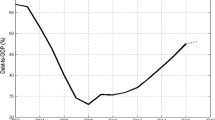Abstract
We study fiscal consolidations in the Central and Eastern European countries and what determines the probability of their success. We define consolidation events as substantive improvements in fiscal balances adjusting for the impact of cyclical effects. We use logit models for the period 1991–2003 to assess the determinants of the success of a fiscal adjustment. The results seem to suggest that for these countries expenditure based consolidations have tended to be more successful. By contrast, revenue-based consolidations have a tendency to be less successful.
Similar content being viewed by others
References
Aarle, B. van, and H. Garretsen (2003). Keynesian, Non-Keynesian or No Effects of Fiscal Policy Changes? The EMU Case. Journal of Macroeconomics 25 (2): 213–240.
Afonso, A. (2001). Non-Keynesian Effects of Fiscal Policy in the EU-15. ISEG/DE Working Paper 07/2001/DE. Technical University of Lisbon, Department of Economics, Lisboa.
Alesina, A., and S. Ardagna (1998). Tales of Fiscal Adjustment. Economic Policy 27 (October): 489–545.
Alesina, A., and R. Perotti (1995). Fiscal Expansions and Adjustments in OECD Countries. Economic Policy 21 (October): 205–248.
Alesina, A., and R. Perotti (1997). Fiscal Adjustments in OECD Countries: Composition and Macroeconomic Effects. IMF Staff Papers 44 (2): 210–248.
Backé, P., C. Thimann, O. Arratibel, O. Calvo-Gonzalez, A. Mehl, and C. Nerlich (2004). The Acceding Countries’ Strategies towards ERM II and the Adoption of the Euro: An Analytical Review. ECB Occasional Paper 10. European Central Bank, Frankfurt/M.
Bertola, G., and A. Drazen (1993). Trigger Points and Budget Cuts: Explaining the Effects of Fiscal Austerity. American Economic Review 83 (1): 11–26.
Blanchard, O., and R. Perotti (2002). An Empirical Characterization of the Dynamic Effects of Changes in Government Spending and Taxes on Output. Quarterly Journal of Economics 117 (4): 1329–1368.
De Arcangelis, G., and S. Lamartina (2003). Identifying Fiscal Shocks and Policy Regimes in OECD Countries. ECB Working Paper 281. European Central Bank, Frankfurt/M.
EC (European Commission) (2003). Public Finances in EMU. Luxembourg: Office for Official Publications of the European Communities.
EC (European Commission) (2004). European Economy, No. 5/2004. Economic Forecasts, Autumn 2004. Luxembourg: Office for Official Publications of the European Communities.
Frenkel, M., and C. Nickel (2005). Shocks and Shock Adjustment Dynamics in the Euro Area and the CEECs. Journal of Common Market Studies 43 (1): 53–74.
Giavazzi, F., and M. Pagano (1990). Can Severe Fiscal Contractions Be Expansionary? Tales of Two Small European Countries. In O. Blanchard and S. Fischer (eds.), NBER Macroeconomics Annual 1990. Cambridge, Mass.: MIT Press.
Giavazzi, F., and M. Pagano (1996). Non-Keynesian Effects of Fiscal Policy Changes: International Evidence and the Swedish Experience. Swedish Economic Policy Review 3 (1): 67–103.
Giavazzi, F., T. Jappelli, and M. Pagano (2000). Searching for Non-Linear Effects of Fiscal Policy: Evidence from Industrial and Developing Countries. European Economic Review 44 (7): 1259–1289.
Gupta, S., L. Leruth, L. de Mello, and S. Chakravarti (2001). Transition Economies: How Appropriate Is the Size and Scope of Government? IMF Working Paper WP/01/55. International Monetary Fund, Washington, D.C.
Hagen, J. von, A. Hallett, and R. Strauch (2001). Budgetary Consolidation in EMU. Economic Papers 148, European Commission, Brussels.
Hjelm, G. (2002). Is Private Consumption Growth Higher (Lower) during Periods of Fiscal Contractions (Expansions)? Journal of Macroeconomics 24 (1): 17–39.
Heylen, F., and G. Everaert (2000). Success and Failure of Fiscal Consolidation in the OECD: A Multivariate Analysis. Public Choice 105 (1/2): 103–124.
McDermott, C., and R. Wescott (1996). An Empirical Analysis of Fiscal Adjustments. International Monetary Fund Staff Papers 43 (4): 725–753.
Perotti, R. (1998). The Political Economy of Fiscal Consolidations. Scandinavian Journal of Economics 100 (1): 367–394.
Purfield, C. (2003). Fiscal Adjustment in Transition Countries: Evidence from the 1990s. IMF Working Paper WP/03/36. International Monetary Fund, Washington, D.C.
Tondl, G. (2004). Macroeconomic Effects of Fiscal Policies in the Acceding Countries. Mimeo. Vienna University of Economics.
Vinhas de Souza, L., and D. Borbély (2003). A Primer on Budgetary Questions on the New EU Members States. Mimeo. The Kiel Institute for the World Economy.
Zaghini, A. (1999). The Economic Policy of Fiscal Conditions: The European Experience. Temi di Discussione 355, June. Banca d’ Italia, Rome.
Author information
Authors and Affiliations
Corresponding author
Additional information
JEL no.
C25, E62, H62
About this article
Cite this article
Afonso, A., Nickel, C. & Rother, P. Fiscal Consolidations in the Central and Eastern European Countries. Rev. World Econ. 142, 402–421 (2006). https://doi.org/10.1007/s10290-006-0073-9
Issue Date:
DOI: https://doi.org/10.1007/s10290-006-0073-9




